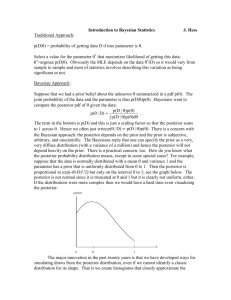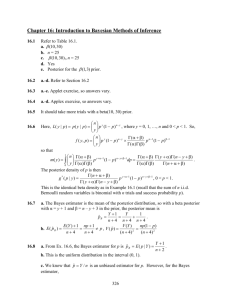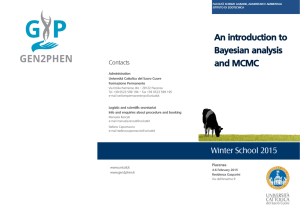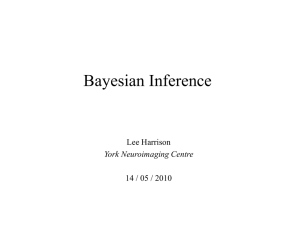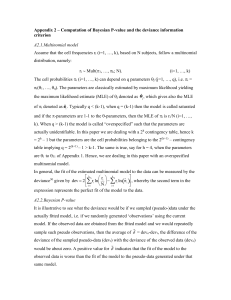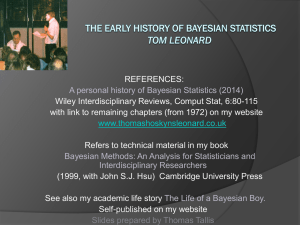Notes 28 - Wharton Statistics Department
advertisement
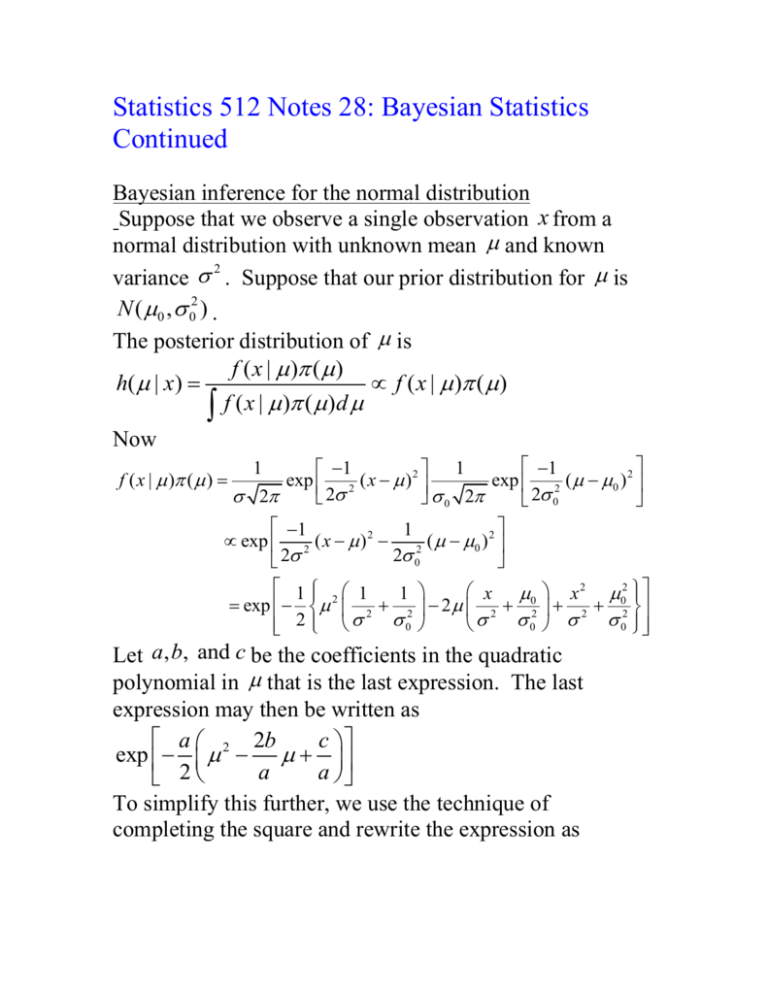
Statistics 512 Notes 28: Bayesian Statistics Continued Bayesian inference for the normal distribution Suppose that we observe a single observation x from a normal distribution with unknown mean and known 2 variance . Suppose that our prior distribution for is N ( 0 , 02 ) . The posterior distribution of is f ( x | ) ( ) h( | x ) f ( x | ) ( ) f ( x | ) ( )d Now f ( x | ) ( ) 1 1 1 1 exp 2 ( x ) 2 exp 2 ( 0 ) 2 2 2 0 2 2 0 1 1 exp 2 ( x ) 2 2 ( 0 ) 2 2 0 2 1 2 1 x 0 x 2 02 1 exp 2 2 2 2 2 2 2 0 0 0 2 Let a, b, and c be the coefficients in the quadratic polynomial in that is the last expression. The last expression may then be written as a 2b c exp 2 a a 2 To simplify this further, we use the technique of completing the square and rewrite the expression as 2 2 a b a 2 c b exp exp a 2 2 a a The second term does not depend on and we thus have that 2 a b h( | x) exp a 2 This is the density of a normal random variable with mean b 1 a and variance a . Thus, the posterior distribution of is normal with mean x 0 2 2 0 1 1 1 2 2 0 and variance 1 12 1 1 . 2 02 Comments about role of prior in the posterior distribution: The posterior mean is a weighted average of the prior mean and the data, with weights proportional to the respective precisions of the prior and the data, where the precision is equal to 1/variance. If we assume that the experiment (the observation of X ) is much more informative than the prior 2 2 distribution in the sense that 0 , then 12 2 1 x Thus, the posterior distribution of is nearly normal with 2 mean x and variance . This result illustrates that if the prior distribution is quite flat relative to the likelihood, then 1. the prior distribution has little influence on the posterior 2. the posterior distribution is approximately proportional to the likelihood function. On a heuristic level, the first point says that if one does not have strong prior opinions, one’s posterior opinion is mainly determined by the data one observes. Such a prior distribution is often called a vague or noninformative prior. Inference for sample of more than one observation We now consider the posterior distribution when an iid 2 2 sample ( X 1 , , X n ) ~ N ( , ) is taken where is known 2 and as before, we use the prior distribution N ( 0 , 0 ) . As before, the posterior distribution is proportional to h( | x1 , , xn ) f ( x1 , , xn | ) ( ) . From the independence of the X i ’s, 1 1 exp 2 2 n (2 ) n / 2 Using the identity, f ( x1 , , xn | ) 2 ( x ) i 1 i . n i1 ( xi )2 i1 ( xi x )2 n( x )2 n n we obtain f ( x1 , , xn | ) 1 1 exp 2 2 n (2 ) n / 2 1 2 2 ( x x ) exp ( x ) i 2 2 / n i 1 n Only the last term depends on , so 1 h( | x1 , , xn ) exp 2 ( x ) 2 ( ) 2 / n This posterior distribution can be evaluated in the same way as the single observation case with x replacing x and 2 / n replacing 2 . Thus, the posterior distribution is normal with mean 0 nx 02 2 1 n 1 2 2 0 and variance 1 12 n 1 2 02 2 For large values of n , 1 x and n . Therefore, the information in the sample largely determines the posterior distribution for large samples. 2 1 Bayesian inference: Point estimation: When faced with a decision, the Bayesian wants to minimize the expected loss (i.e., maximize the expected utility) of a decision rule under the prior distribution ( ) for . In other words the Bayesian chooses the decision rule d that minimizes the Bayes risk: B(d ) E ( ) [ R( , d )] , i.e., the Bayesian chooses to use the Bayes rule for the Bayesian’s prior distribution ( ) As we showed in Notes 26, for point estimation with squared error loss, the Bayes rule is to use the posterior mean as the estimate. Thus, for the above normal distribution setup, the Bayesian’s estimate of is x 0 2 2 0 1 1 2 02 Interval estimation: A Bayesian version of a confidence interval is called a credibility interval . A 100(1 )% credibility interval is an interval of the form (0 ,1 ) , where 1 0 h( | x)d 1 . , X n ) iid N ( , 2 ) where 2 is 2 known and the prior distribution is N ( 0 , 0 ) , the posterior For example, for ( X 1 , 0 nx 2 2 1 0 N , n 1 n 1 distribution for is and a 95% 2 2 2 2 0 0 credibility interval for is 0 nx 02 2 1 1.96 n 1 n 1 2 02 2 02 The frequentist confidence interval is not a probability statement about . The Bayesian credibility interval is a statement about . For the Bayesian, once the data x has been observed, the interval is fixed and is random. Hypothesis testing: Consider testing H 0 : 0 vs. H a : 0 . For the prior distribution, we need to put prior probabilities on H 0 and H a and then put a prior on under H a . If we use the following 0-1 loss function 0 if H i L( , Hypothesis i chosen)= , 1 if H i the posterior risk is minimized by choosing the hypothesis that is more probable under the posterior distribution. Thus, the Bayes rule is to choose the hypothesis that is more probable under the posterior distribution. Bayesian hypothesis testing is a complex topic. The difficulty is that, unlike in estimation problems, the prior is influential even in large samples and so must be chosen carefully. Chapter 15 from Rice, Mathematical Statistics and Data Analysis provides another example of Bayesian inference of Bayesian analysis for the binomial distribution. Review of course I. Three basic types of statistical inferences (Chapter 5): 1. Point estimation -- best estimate of parameter 2. Confidence intervals – how much uncertainty is there in our estimate of the parameter. 3. Hypothesis testing – choose between two hypotheses about the parameter. II. Monte Carlo method for studying properties of inference procedures and bootstrap method for constructing confidence intervals based on Monte Carlo simulations (Chapters 5.8-5.9) III. Maximum likelihood method of making statistical inferences and its properties (Chapter 6) IV. Optimal point estimators: Cramer-Rao Lower Bound (Chapter 6), sufficiency (Chapter 7.1-7.3), Rao-Blackwell Theorem (Chapter 7.3). V. Optimal hypothesis testing (Chapters 8.1-8.3). VI. Decision theory (Chapter 7.1, my notes) VII. Bayesian statistics (Chapter 11.1-11.2, my notes).
